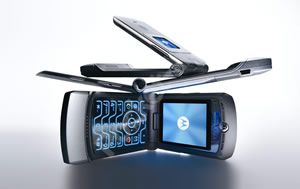Simply bloody wow! As a child you are always reminded to never judge a book by it’s cover. When the new Motorola Razr V3 arrived in a solid aluminium, slide apart case, I breathed easy and remembered those words. Upon opening case and gazing at the V3, books, cover, mobiles and about everything else went out the window. The V3 simply looks the cats-ankle.
Our quick take
Overall the Razr V3 is a stunning mobile phone. Slim and metallic, the whole handset presentation screams of futuristic minimalism while harking back to the childhood sci-fi of audience it's aimed at. The specs are still to vague to really be able to tell if this phone will stand the scrutiny of inspection beyond the outer shell, but in the meanwhile, I'd happily suffer the frustrations of the functionality, simply to be a early owner.

Motorola Razr V3 mobile phone - 4.0 / 5
| FOR | AGAINST |
|---|---|
|
|
The body is thinner than an After Eight chocolate and only slightly less minty. The anodized aluminium case measures 89x53x13.9mm and weighs 95grammes. The antenna has been integrated into the framework, like a number of the ‘V’ series before it, and this design feature lends itself well to the futuristic feel of the outside shell. The designers have grappled back to the late 80’s for inspiration for the keypad and replaced the standard set of crude plastic buttons with covering of nickel-plated copper-alloy, with the numbers and symbol chemically etched into it. Placed behind the keypad is an electro-luminescent strip, which illuminates the keys like a character from ‘Tron’. To make the key depressions functional, a sprung secondary layer gives the depressions somewhere to go when pushed.
Looking good is one thing but does the blessed thing actually perform as a phone? Well for starters it’s a quad-band. Yes quad, 850, 900, 1800 and1900, up until now we’d all been impressed by tri-band devices, where the new band arrived from, no idea, but it’s here and we want it, apparently! The internal battery is charged via the mini-USB port on the left hand side and the battery life is very good. The literature included at the time, of this review, was vague to say the least, quoted 204-400 minutes talk-time and 156 - 250 hours standby time.
Beyond the emaciated flare of the bodies design, the actual layout has been heavily borrowed from the ‘V’ series, with the small outer screen and larger inner screen being familiar to current Motorola users. Outside you’re teased by 96x80 pixel, 4K colour screen, offering phone status and self-portrait options, which are dwarfed by the 176x220 pixel, 64K colour screen on the inside. Slim-line fast-keys on the flip section allow you to activate the self-portrait camera option as well as capture images once they hove into view. The camera also offers a very presentable 4x zoom feature and the lens is protected by a section of toughened glass to avoid scratches. For lovers of the moving image MPEG 4 videos can be recorded and played back complete with 22 kHz polyphonic sound. The V3 has been fully enabled for Java and supports MIDP2.0, enabling advanced games and applications to run, including a strange 3D contact phone book
Core functionality is typically Motorola, i.e. those who know the OS already will smile sagely and those who don’t will look puzzled. The ‘iTap’ MMS / EMS text entry system is as frustrating as usual and will have non-devotees clamouring for a T9 version. There is also something ‘iffy’ about the keystroke repeat-speed, as I found characters often got duplicated. The V3 offers both Internet and e-mail and has even included ‘Wireless Village instant messenger’. The demo version I was looking at had problem locating a GPRS signal, to get online, but I put this down to mis-configuration of the handset with my SIM, rather than a fault. More worrying, the search for the internet set-up menu seemed totally fruitless, so pre-sets could not be checked. Localised connectivity comes in the form of Bluetooth and active sync, the sync cable using the same port as the charger.
The V3 supports two simultaneous lines and offers separate ring tones for each, which indicated that this might be aimed at the business user. Whether O2, the sole network the V3 will initially be available on, also supports duel-line contracts is another thing.
To recap
Looks great and performs well - this will become an icon in the mobile phone world
